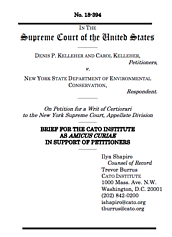When the government takes a landowner’s property for public use, it must provide just compensation under the Takings Clause of the Fifth Amendment. This applies not only when the government physically takes land, but also when a regulation diminishes the property’s value, as happened to the Kellehers. The Supreme Court’s 1978 opinion in Penn Central Transportation Co. v. City of New York established the framework evaluating for regulatory takings claims. Under Penn Central, courts must consider the economic impact of a regulation, the regulation’s impact on investment-backed expectations, and the character of the government action. This test has been notoriously difficult for courts to apply, however, and lower courts often let just one Penn Central factor dispose of the entire claim.
That’s what happened when the Kellehers brought a takings claim in an attempt to recover their losses. The New York Appellate Division agreed that this was a “text book case” of a taking, yet nevertheless dismissed their claim under New York’s “absolute-right” rule — which provides that if a regulation is passed that restricts land use, and someone later buys an affected plot of land, they are barred from bringing a takings claim. Since New York passed its environmental regulations in 1973, and they purchased the property in 1999, the Kellehers were out of luck.
Cato has filed an amicus brief in support of the Kellehers’ petition to the Supreme Court. We argue that the Penn Central test was never intended to limit the Takings Clause in such a drastic way. In fact, the Supreme Court has repeatedly found that the Takings Clause does not have a time limit. Yet New York’s “absolute-right” rule puts an expiration date on the Takings Clause, reduces Penn Central to a single-factor test, and hands undeserved victories to the government. In fact, the government wins in 90 percent of takings cases where Penn Central is applied, and lower courts are in need of direction on how to apply the Penn Central test.
Not only have the Kellehers lost nearly half a million dollars, but they have also lost nearly two decades simply trying to build a home on their private property. If Penn Central’s confusing terms were simplified — especially the concept of “investment-backed expectations” — perhaps lower courts would finally apply this test in a consistent manner and give property owners a chance to prevail when the government goes too far. The Court should take the case to clarify the Penn Central test and affirm that the government cannot put a time limit or a dollar amount on the Takings Clause.




